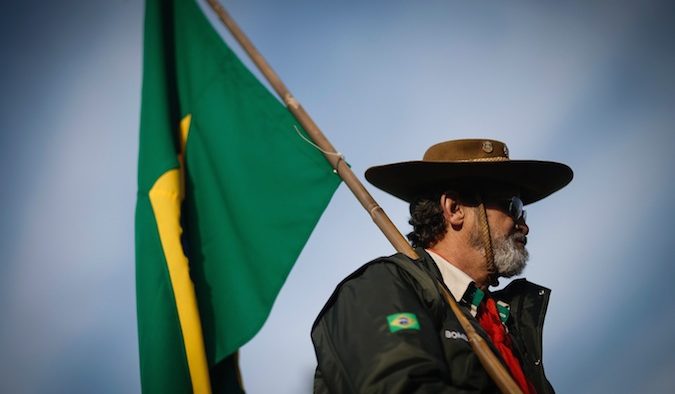The three contradictions that define the Olympics brand
Share

Image: A man holds the Brazilian flag during the Rio 2016 Olympic torch relay / André Luiz Mello.
_
As Rio’s turn to host the Games continues, Ken Shadbolt reflects on his experience working on the look of Sydney 2000 to explore a seemingly incongruous orchestration of three dichotomies that define the Olympics brand.
 Love it or loathe it, there’s no denying the inexorable rise and influence of the Olympic Movement throughout the 20th and (so far at least) 21st centuries. Whichever way you look at it – the world’s largest sporting event, the world’s biggest sporting franchise or the world’s largest television audience – the numbers alone are extraordinary. Add to that the profound cultural and historical dimensions of the Olympic Movement and it becomes something of a phenomenon worthy of closer scrutiny.
Love it or loathe it, there’s no denying the inexorable rise and influence of the Olympic Movement throughout the 20th and (so far at least) 21st centuries. Whichever way you look at it – the world’s largest sporting event, the world’s biggest sporting franchise or the world’s largest television audience – the numbers alone are extraordinary. Add to that the profound cultural and historical dimensions of the Olympic Movement and it becomes something of a phenomenon worthy of closer scrutiny.
At the centre of the Movement’s success is one of the most sought after brand associations on the planet. No other brand has captured the hearts and minds of successive generations of athletes, governments, sponsors, broadcasters and spectators in the same way.
But why? What separates the Olympics Games from any other sporting world championships? Why is the Olympic brand so revered?
In exploring the helm of the Olympic Movement – the International Olympic Committee (IOC) – you’ll find a seemingly incongruous orchestration of three dichotomies that define the Olympic brand.
1. Idealism and commercialism
Imagine a brand that combines the best of Nike with the best of the United Nations and you’re some way towards understanding why the Olympic brand is so powerful.
On one hand, the Olympic brand behaves like a humanitarian brand. It places idealism and morality above all other interests. On the other hand, its association with the world’s hottest contemporary athletes gives it an edge and dynamism unlike any non-commercial organisation.
I was a little sceptical after hearing the Games referred to in one briefing session as “a place where the world of sport and a yearning for peace meet”. While it’s easy to dismiss such lofty notions as idealistic and out of touch, it’s precisely these values that elevate the brand beyond any other sporting event, and allow Olympism to fulfil some fundamentally human need to aspire to a higher purpose. Paradoxically, it’s these same Olympic values that are the source of the brand’s commercial value.
Commercial partners are critical to securing the enormous financial requirements of organising the world’s largest event. But it’s by no means laissez-faire. These commercial partners pay handsomely with the expectation of the IOC ruthlessly protecting and upholding the Olympic values even when it may restrict their own communication plans. The IOC’s ability to achieve its financial requirements without compromising the Olympic ideals is critical to the brand’s success.
It’s not often appreciated that the IOC has mandated a strict ‘clean’ venue policy prohibiting any commercial sponsorship on the sporting field-of-play of all events at the Games. As Sydney’s program manager of Look, Susie Grierson rightly pointed out in the lead-up to the 2000 Games, the Olympic arena must feel ‘sacrosanct’. Many athletes cite this commercial-free approach as what separates the Olympic Games from all other sporting experiences. There are stories of hardened professional athletes who plan to treat the Games ‘just like any other event’ only to walk out onto the pristine arena to be completely overwhelmed by the sight of the Olympic rings in this context.
While the IOC is famous for its tough negotiating tactics to secure the highest bids for broadcasting rights, it has also turned away higher bids from private broadcasters to keep the Games with a free-to-air channel. This ensures it remains true to its values by allowing everyone with access to a television to afford to watch the Games.
It is this fine balance of humanitarian values and commercial appeal that sits at the heart of the brand.
2. Ruthless consistency and constant reinterpretation
It is sometimes said that the Olympic Movement is just one bad Games away from total disaster.
In the lead-up to the Sydney Games, we were extremely aware of the need to deliver something special that would restore faith in the Olympic Movement after the controversy of rogue commercial agendas had undermined the previous Games in Atlanta. While Sydney 2000 was lauded as “the best Games ever” by outgoing IOC president Juan Antonio Samaranch, Atlanta was something of a close call for the IOC, and one that heightened its desire for control of every aspect of future Games.
The Olympic brand has since become one of the most tightly managed and highly protected brands in the world today. However, the IOC must carefully walk a line of assuredness of delivery without suppressing the individuality of each host city’s approach.
Imagine for a moment there were no host cities, and every Olympic Games was held in the IOC’s hometown of Lausanne, Switzerland. Certainly it would provide a substantial cost saving, fewer security concerns, far less political complexities and the opportunity to hone a perfectly consistent Games experience year after year. But this predictability would kill one of the defining characteristics of the Olympic brand – constant cultural reinterpretation.
It’s the interpretation of Olympic values through a local cultural lens that reinvigorates the Games every few years. This diversity also fulfils a very practical requirement to provide the footage of each Games with a unique ‘cultural date stamp’ allowing easy identification of historical footage in subsequent years.
In recent years, the Olympic brand has become considerably richer for the ancient connections of Athens 2004, the sheer spectacle of Beijing 2008 and the youth focus of the London 2012 Games.
Hosting an Olympic Games is one of the most high-stakes franchises imaginable. From the IOC’s perspective, it hands its most cherished possession – the reputation of the Olympic brand – to a new host city at each Games. From the host city’s perspective, it will be challenged to both nurture and protect the Olympic brand while imbuing the Games with its local cultural perspective.
This opportunity sees governments and most creative professionals clambering for the international credibility that a potential Olympic association may bring. Get it right and the host cities can share in an economic, cultural and reputational afterglow for years to come. However, as we saw with Atlanta, get it wrong and risk suffering the scrutiny and indignation of the world’s media.
3. Ancient traditions and progressive leadership
Having to contemplate what it meant for Sydney to host the ‘Millennium Games’ seemed at times to be an impossible conundrum. This wrestling of meaning and relevance between ancient traditions and modern expectations is another defining aspect the Olympic brand.
In 1896, the founder of the modern Games, Pierre de Coubertin, revived the spirit of the Ancient Games from Olympia in Greece as the basis of the modern Games. With that decision came symbols, ceremonies and rituals that continue to imbue and differentiate the Olympic brand today.
With a heritage older than Christianity, and not unlike a modern day religion, the Olympic Movement must navigate respect for the traditions that have served the brand well over many decades, while needing to remain relevant to future generations. Even today, the flame that lights each Olympic Cauldron is still ignited by the sun at a strangely ancient ceremony in Olympia, before making its way via the torch relay to the host city. In today’s increasingly cynical world, how much longer can the Games continue these traditions?
And yet, despite perceptions of the IOC as a bureaucratic custodian obsessed with preserving Olympic traditions, there’s mounting evidence to suggest it is acutely aware of the need for progressive leadership.
Who would have thought a few years ago that an Olympic gold medal would be awarded for sports like BMX or snowboarding? The decision to include these sports was a deliberate attempt by the IOC to widen the appeal of the Olympic brand to include teenagers more interested in EPSN’s X Games than anything Olympic.
Among 40 initiatives aimed at keeping the Games relevant in the coming years is an extraordinary initiative aimed at encouraging mixed gender sports. Even in the highly progressive world of commercial sport, the introduction of mixed gender sports could see the Olympic Movement take the lead to challenge one of the final frontiers of equality in sport – a radical departure from the Ancient Games’ exclusively masculine traditions.
And so, with the mandatory pre-Games jitters now upon Rio – political instability, economic uncertainty, water quality issues and a looming Zika virus catastrophe – there’s plenty for the IOC to worry about.
Having experienced firsthand how Sydney worried its way throughout the lead-up to one of the most successful Games (remember the concerns over threats of terrorism, traffic chaos and a supposedly woeful Opening Ceremony?), I’m confident that once the Cauldron is alight and Brazil tastes success on the sporting field, the Olympic Movement will be all the stronger for adding its first Latin American chapter to its remarkable narrative.
_
Ken Shadbolt is co-founder and executive creative director at brand consultancy PUSH Collective. Ken was group design director of the team that created the emblem and look of the Sydney 2000 Olympic Games. He has also created brand identities for many sporting brands, including Cricket Australia, Melbourne 2006 Commonwealth Games, 2007 FINA World Championships, One HD, Mark Webber and is currently working with the AFL to create the new Women’s League logo.
_
This article first appeared in The Content Issue of Marketing. Buy the issue or subscribe for more »















